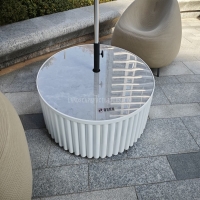Welcome to the website for landscape facilities products and knowledge.
How does the table’s surface affect the reflection of light, and are there anti-glare options available?
The interaction between light and table surfaces plays a crucial role in visual comfort and functionality. When light strikes a table surface, its behavior depends primarily on the material's texture and finish. Glossy surfaces, such as polished wood or laminated tables, create specular reflection where light bounces off at equal angles, resulting in sharp, mirror-like glare that can cause eye strain and reduce visibility. Conversely, matte or textured surfaces produce diffuse reflection, scattering light in multiple directions to create softer, more evenly distributed illumination.
The science behind this phenomenon lies in surface microstructures. Smooth surfaces allow parallel light waves to remain organized upon reflection, creating intense glare spots. Rough surfaces, even those that appear smooth to the naked eye, contain microscopic irregularities that break up light waves, dispersing them randomly.
Several effective anti-glare options are available for those seeking to minimize reflective discomfort. Matte finishes, achieved through specialized manufacturing processes or protective coatings, fundamentally alter how surfaces interact with light. These finishes contain tiny particles or textures that disrupt direct reflection. Anti-reflective coatings represent another solution - thin, transparent layers applied to table surfaces that use interference principles to cancel out reflected light waves.
For existing tables, practical solutions include anti-glare desk mats or pads that provide an immediate diffuse surface. Positional adjustments, such as angling the table away from direct light sources or using strategic lighting placement, can also significantly reduce glare issues. The choice between these options depends on aesthetic preferences, functional requirements, and the specific lighting conditions of the environment.
Modern manufacturing has also developed hybrid surfaces that balance visual appeal with practical anti-glare properties. These advanced materials maintain an attractive appearance while incorporating light-diffusing technology at the microscopic level. When selecting table surfaces for workspaces, reading areas, or environments where visual clarity is essential, understanding these light reflection principles enables informed decisions that enhance comfort and productivity.
Related search:

Recommendation
Round metal tube border design table with tempered glass or granite countertop on the top.